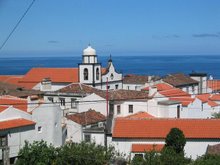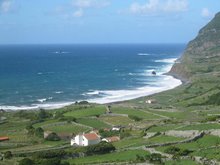We call them Cory's Shearwaters but Azoreans call them Cagarros - handsome big chocolate brown seabirds of the albatross family, much bigger than the Manx Shearwater we are used to in British waters.

The Cagarro spends most of its life at sea but comes ashore to breed in summer. I believe about 60% of the world population of cagarros breed on the Azores. And when they are here breeding on the cliffs of Flores, they don't half make a distinctive noise. "Wack-wack-wack-wack-WAAAAAAAAAACK" at night, as they wheel in flight above the village at night. Summer holidaymakers in Faja Grande are warned "If you hear a funny noise, it's the cagarros."
All of which is a long winded introduction to say I heard my first cagarro of 2007 last night.
I found myself explaining this about the cagarros to the first tourist on Flores of 2007. Is it global warming bringing the first tourist and first cagarro in February?




8 comments:
That's a sound that always carries my memory away to Flores. I was only six when my grandfather died, but i remember so well when he explained me, at the balcony, to distinguish a female from a male. I never forgot. So if you don't know that yet, it's like men and women, a low (grave) sound for male and higher sound (agudo) for female.
Do you know Luísa Furtado? She´s my cousin, but she's always home, being older than she is, ehehhe.If you see her say that i send regards.
I am happy to see you posting again, as I am hungry for information about the Azores--still planning to make a trip there, but don't know when.
To Carol and Neil, My grandparents must have heard the same bird cries when they were small children in Fajãzinha and Fajã Grande. I now feel yet another step more closely linked to them thanks to your posting.
To Marisa: In family letters from Ponta de Fajã Grande (1920s, 1930s) to my great-grandmother in the US, I found references to people named Furtado. Do you think your cousin Luísa might be related to them? Are all Furtados around Fajã Grande related to one another? Please contact me via the email address on my webpage (find it on my homepage by clicking on my name just above this message). Obrigada.
Kathie, i found several email adresses, wich one is it?
I don´t know if the Furtados are all related, but i can ask her.
Until next time.
Hi Marisa
I don't think we know your cousin Luisa Furtado but there's a Luisa Fagundes Furtado listed in the Phone Book in Faja so that must be her. We will ask Linda - she remembers you fine and sends her regards.
Neil
Thought you might enjoy this account of cagarros (albeit on Pico), which just appeared in the travel article "A Man for Off-Season," by John Deiner, in the Washington Post (Washington, D.C.), page P01, Sunday, March 18, 2007:
http://www.washingtonpost.com/wp-dyn/content/article/2007/03/16/AR2007031600749.html
"In the predawn darkness, an otherworldly shriek jarred us awake. Another came a few seconds later, then another. The warbly cackling was now more comical than frightening, as if a couple of munchkins were enjoying a good laugh in the trees outside our bedroom window. It was the wakeup call of the resident Cory's shearwaters, seabirds that descend en masse in the spring. Evidently, a few had arrived a bit early and were overjoyed to be there... Then the screeching faded [and] the sky turned rosy..."
Our first "Cagarro experience" also occurred on Pico. Those "otherworldly" creatures probably had a good laugh watching us point the digital camera skyward in the dark. Never did get a photo of them but some great audio.
Great description. I wished I knew this before I went to Corvo.
Being the only (camping)tent on the Corvo Island, the first night I was really scared. It sounded like VODO-sounds. The second night I went outside to see that it was a bird. But it is a sound I will never forget. July 2009 (Back in Holland)
Post a Comment